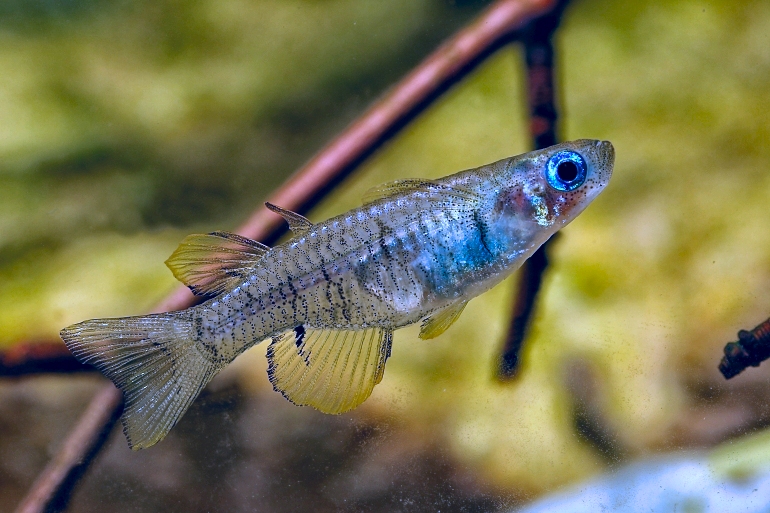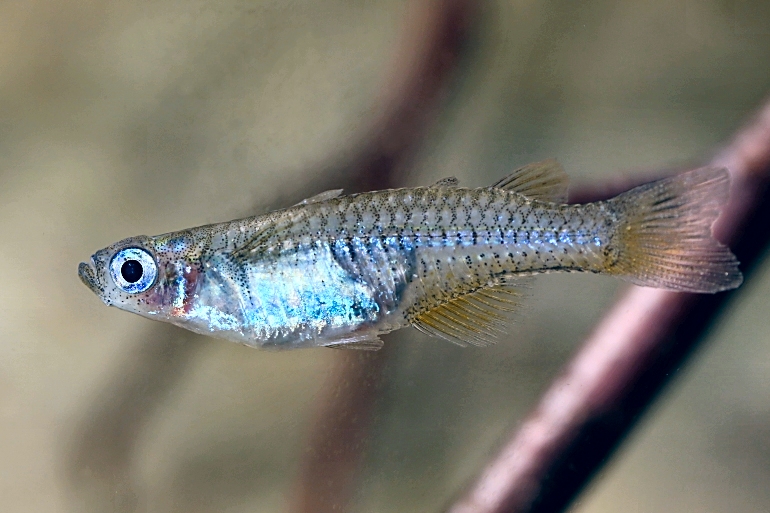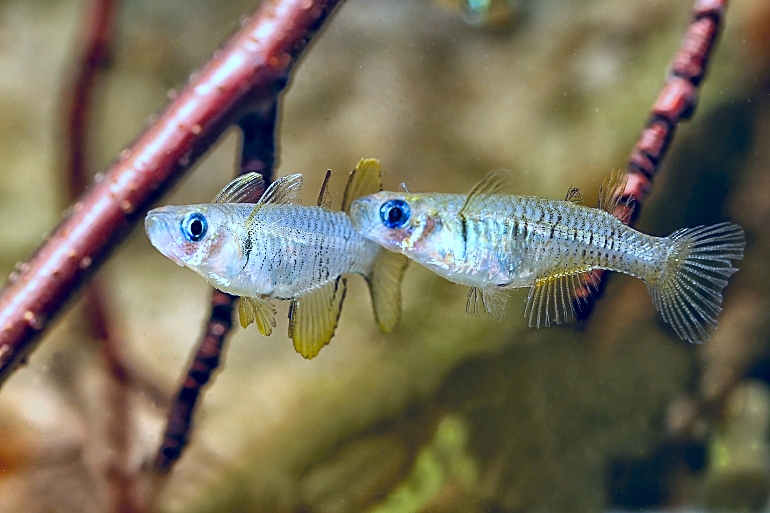|
 |
Pseudomugil paludicola (male) Timika region - photo© Andreas Wagnitz |
Allen and Moore, 1981
Swamp Blue-eye
Species Summary
Pseudomugil paludicola are a small species growing to a maximum size of around 4-5 cm. They have a translucent body, with silvery head and abdomen. The pelvic fins are yellowish. The edge of the second dorsal fin in males is yellowish. In females, the caudal fin base is yellowish and the anterior portion of the anal fin is pale yellow. Males are easily distinguished from females by their brighter colours and longer and more elongated dorsal fin. Females are smaller and have smaller fins but lack the colours of the males.
Pseudomugil paludicola differs from other members of the genus by virtue of the anal fin-ray count, rearward position of the dorsal fins, small size and inconspicuous nature of the first dorsal fin and the presence of an unsegmented spine at the beginning of the anal fin. The modal number of 14 total fin-ray elements (includes spine) in the anal fin is the highest for the genus. Pseudomugil inconspicuus and P. gertrudae sometimes possess 13 elements, but they lack an unsegmented spine at the beginning of the anal fin. The two dorsal fins of P. paludicola are set far back on the body; the origin of the first dorsal fin is level with the base of the fourth or fifth soft anal ray, and that of the second dorsal fin with the base of the posteriormost anal rays. Most other members of the genus, including P. gertrudae, P. novaeguineae, P. signifer, and P. tenellus have the dorsals in a more anterior position; the origin of the first dorsal fin is placed either well ahead or about even with the anal fin origin, and that of the second dorsal fin is level with the middle or anterior portion of the anal fin. The dorsal fins of P. inconspicuus from the lower Fly River are positioned similarly to those of P. paludicola, but this species differs by having an accessory ascending process on the premaxillary bone and sexual dimorphism manifested by males having slightly larger dorsal and anal fins, sometimes with short filamentous extensions of the anterior ray. The first dorsal fin of P. paludicola is much reduced in size compared to that of other Pseudomugil. It usually consists of three extremely feeble spines and is difficult to detect without the aid of a microscope. Unlike other Pseudomugil, the depressed rays of the first dorsal fall well short of the origin of the second dorsal fin, even in mature males.
There are probably a number of geographically isolated populations that have their own distinctive colouration. A variety collected from the Sorong area in West Papua have a semi-transparent body and when viewed under overhead lighting the dorsal area of the male's body has a beautiful blue coloration much like Pseudomugil cyanodorsalis but not as intense. The pelvic, pectoral and anal fins show a slight hint of yellow. A yellow coloured form has been reported from the upper Kikori River in Papua New Guinea.
 |
Pseudomugil paludicola (female) Timika region - photo© Andreas Wagnitz |
Distribution & Habitat
Pseudomugil paludicola were first collected in 1973 by R. Moore in a mangrove creek near Bulla at the mouth of the Morehead River, Papua New Guinea. They are also reported as being very common in the swamplands of the lower Pahoturi River. However, they are probably widely distributed in coastal streams over much of southern New Guinea. Other collections have been in the Sorong region in West Papua and the Kikori and Binaturi river systems in Papua New Guinea. Specimens were collected by G. Allen and B. Parkinson from a small creek in coastal rainforest about 5 km inland from Tureture Village near a walking track to Binaturi River in September 1979. Gerald Allen visited the area in late September at the end of the dry season. Most of the small streams were dry and standing freshwater was scarce, but after inquiring at Tureture Village a group of young boys located a small stagnant pool deep in the jungle about 5 km inland. Several drags with a one-man seine net revealed that the pool contained hundreds of P. paludicola. A few P. gertrudae and Melanotaenia rubrostriatus were also collected. The dimensions of the pool were approximately 4 x 1.5 metres with a maximum depth of about 0.6 metres. This pool was the last remaining water in a small tributary of the Binaturi River, which is typical of the larger streams flowing into the Torres Strait region. Water turbidity in the pool was moderate and a temperature of 26.8°C and pH of 7.6 were recorded.
Remarks
This species was named "paludicola" (Latin for "swamp dweller") with reference to its habitat. In 1979 Gerald Allen returned to Australia with live specimens but unfortunately they departed this life before any were bred and distributed in the hobby. Another collection was made in the Sorong area and small populations were established in the Europe and North America. Eggs were imported into Australia in 1996 whereupon they were bred, but again, failed to become established in the hobby. In 2018 live specimens were collected from the Timika region. They where collected from a brackish pond (swamp) near the coast.
 |
Pseudomugil paludicola (pair) Timika region - photo© Andreas Wagnitz |
Preliminary generic studies (P. J. Unmack 2009, pers. comm.) have revealed significant genetic variation between the different populations of P. paludicola that may warrant taxonomical separation at the species level.
Literature
Allen G.R. & R. Moore (1981) Pseudomugil paludicola, a new species of freshwater blue-eye (Melanotaeniidae) from Papua New Guinea. Revue française d'Aquariologie 7(4): 105-108.
Allen G.R. (1991) Field guide to the freshwater fishes of New Guinea. Christensen Research Institute, Madang, Papua New Guinea.
Hansen B. (1995) Kikori kaleidoscope. Fishes of Sahul 9(3): 417-423.
Adrian R. Tappin
Updated July, 2019



|

